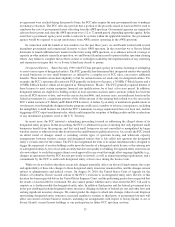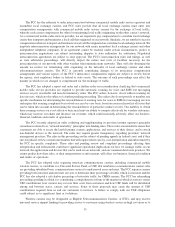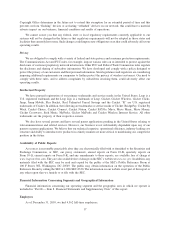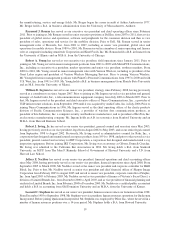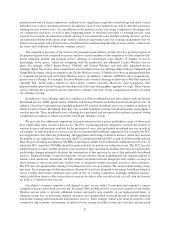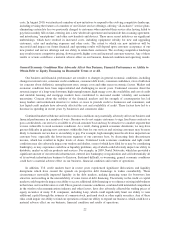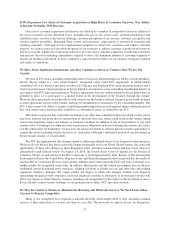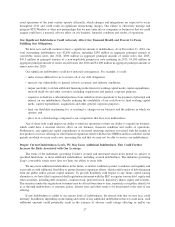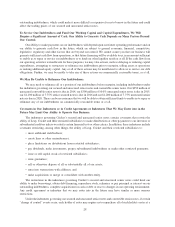Cricket Wireless 2010 Annual Report Download - page 29
Download and view the complete annual report
Please find page 29 of the 2010 Cricket Wireless annual report below. You can navigate through the pages in the report by either clicking on the pages listed below, or by using the keyword search tool below to find specific information within the annual report.If We Experience Low Rates of Customer Acquisition or High Rates of Customer Turnover, Our Ability
to Become Profitable Will Decrease.
Our rates of customer acquisition and turnover are affected by a number of competitive factors in addition to
the macro-economic factors described above, including the size of our service areas, network performance and
reliability issues, our device and service offerings, customer perceptions of our services, customer care quality and
wireless number portability. Managing these factors and customers’ expectations is essential in attracting and
retaining customers. Although we have implemented programs to attract new customers and address customer
turnover, we cannot assure you that these programs or our strategies to address customer acquisition and turnover
will be successful. A high rate of customer turnover or low rate of new customer acquisition would reduce revenues
and increase the total marketing expenditures required to attract the minimum number of customers required to
sustain our business plan which, in turn, could have a material adverse effect on our business, financial condition
and results of operations.
We Have Made Significant Investments, and May Continue to Invest, in Ventures That We Do Not
Control.
We own an 85% non-controlling membership interest in Savary Island through our wholly-owned subsidiary,
Denali. Savary Island is a “very small business” designated entity under FCC regulations, to which Denali
contributed all of its wireless spectrum outside of its Chicago and Southern Wisconsin operating markets and a
related spectrum lease. Our participation in Savary Island is structured as a non-controlling membership interest in
accordance with FCC rules and regulations. We have agreements with our venture partner in Savary Island that are
intended to allow us to participate to a limited extent in the development of the business through the venture.
However, these agreements do not provide us with control over the business strategy, financial goals, build-out plans
or other operational aspects of the venture, and may be terminated for convenience by the controlling member. The
FCC’s rules restrict our ability to acquire controlling membership interests in designated entities during the period
that such entities must maintain their eligibility as a designated entity, as defined by the FCC.
The entities or persons that control Savary Island or any other non-controlled ventures in which we may invest
may have interests and goals that are inconsistent or different from ours which could result in the venture taking
actions that negatively impact our business or financial condition. In addition, if any of the members of any such
ventures files for bankruptcy or otherwise fails to perform its obligations or does not manage the venture effectively,
or if the venture files for bankruptcy, we may lose our equity investment in, and any present or future opportunity to
acquire the assets (including wireless licenses) of, such entity (although a substantial portion of our investment in
Savary Island consists of secured debt).
The FCC has implemented rule changes aimed at addressing alleged abuses of its designated entity program.
While we do not believe that these recent rule changes materially affect our Savary Island venture, the scope and
applicability of these rule changes to these designated entity structures remain in flux and have been subject to
administrative and judicial review. On August 24, 2010, the United States Court of Appeals for the District of
Columbia Circuit vacated certain of the FCC’s revisions to its designated entity rules. Review of this decision has
been requested before the United States Supreme Court, and the petitioning parties have requested that the results of
Auction #66 be overturned. We also cannot predict whether and to what extent the FCC will seek to reinstate or to
further modify the designated entity rules. In addition, third parties and the federal government have in the past
challenged certain designated entity structures, alleging violations of federal qui tam and other laws and seeking
significant monetary damages. We cannot predict the degree to which rule changes, federal court litigation
surrounding designated entity structures, increased regulatory scrutiny or third party or government lawsuits will
affect our current or future business ventures, including our arrangements with respect to Savary Island or our or
Savary Island’s current license holdings or our participation in future FCC spectrum auctions.
We May Be Unable to Obtain or Maintain the Roaming and Wholesale Services We Need From Other
Carriers to Remain Competitive.
Many of our competitors have regional or national networks which enable them to offer automatic roaming
services to their subscribers at a lower cost than we can offer. The networks we operate do not, by themselves,
23


